
Wine
Southern Tasmania: The Future is Cool
Southern Tasmania is one of Australia’s hottest and most promising wine regions. That’s hot in the trend stakes – it’s definitely cool in the climate game.
Surrounded by the moderating influence of three oceans and Bass Strait to the north, Tasmania’s daytime temperatures are rarely extreme and overnight temperatures during ripening are usually cool. The island’s mountainous topography ensures an abundance of north and north-east facing slopes to plant on and an increasingly sophisticated state-wide irrigation infrastructure means access to water is not the risk it once was.
Drawn to the island by these ingredients and the promise of being able to produce elegant cool climate wines, a swag of young, well-travelled winemakers have joined the more established pioneers in recent decades, pushing the local industry into exciting new territory.
Hobart sits like a hub on the wheel of Southern Tasmania’s wine region with the major growing areas of the Coal River Valley, the East Coast, Huon Valley and the Derwent Valley radiating around the city. Lesser known, but rapidly developing areas, including the Tasman Peninsula and the D’Entrecasteaux Channel, fill the gaps between these regions.
With Hobart as a base, wine touring in Southern Tasmania is a joy, as each of these regions is distinctly different. In fact, if you were to highlight something to celebrate about Southern Tasmania as a wine region, it could be its cool climate diversity.
Winemaking redefined
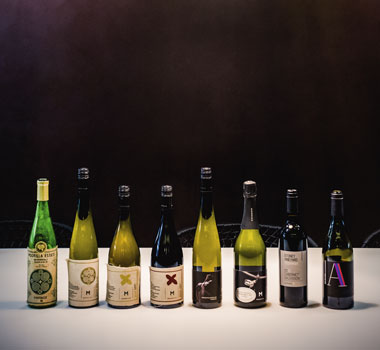

Pictured above (from left to right): A line-up at Moorilla Estate; Moorilla Estate winemaker Conor van der Reest.
Closest to the centre of Hobart’s hub lies Moorilla Estate on the Western bank of the Derwent River. Italian émigré, textile design pioneer and arts patron Claudio Alcorso was well ahead of the pack when he planted 90 Riesling vines there in 1958.
Some visitors may not even notice the vines and winery at Moorilla today, eager as they may be to get to MONA – David Walsh’s extraordinary temple of art – that now shares the peninsula with the vineyard. But Moorilla, as the winemaking arm of MONA, is arguably stronger than ever and no doubt, Alcorso would be proud if he were alive today.
Walsh recruited Canadian winemaker Conor van der Reest in 2007, who championed Moorilla’s terroir and began an ambitious cellaring regime and, in doing so, re-defined winemaking at the vineyard.
Conor may be a long way from home, but his excitement about the potential of wine in Tasmania is palpable.
“Philosophically, I think we’re really a region of unknowns, he says. “We work together across the state to promote Tasmania and there’s a huge desire to see everyone succeed. There’s no one telling us what we need to do, or should be doing, so we’re able to work that out for ourselves. It gives us a big sense of discovery, but also allows us to push internally for continual improvement and quality.”
Across the Derwent to the east is the drier and warmer Coal River Valley, once largely grazing country, where the Moorilla team are now turning their hands to the recently acquired Stony Vineyard, producing the acclaimed Domaine A wines.
Also in this area, just on the outskirts of the colonial Georgian town of Richmond is Pooley Wines. Established around a magnificent sandstone Georgian home, the steep, rocky slopes at Pooley provide the foundations for some of Tasmania’s most celebrated wines. With their cellar door set in the colonial sandstone coach house attached to the home, visiting Pooley Wines is as atmospheric as their wines are rewarding.
Winemaker Anna Pooley and her viticulturalist brother Matthew have greatly expanded from the original vineyard established at nearby Campania by their grandparents in 1985.
Anna believes the unique climate and a growing emphasis on site expression are seeing wines of great flavour depth and robust structure being produced. She talks enthusiastically about the varieties Tasmania is famous for and those beginning to shine.
“I’ll never stop being excited about Chardonnay, Pinot Noir and Riesling. However, Syrah (Shiraz) is proving to be an excellent variety on the warmer sites and presents a richer style of red compared to the elegant Pinots coming out of the south.”
Pooley and many other Tasmanian winemakers are now producing wine, especially Pinot Noir, more Burgundian in the production methods, but also uniquely Tasmanian in character. With more whole bunches and stems used during fermentation and longer barrelling, today’s Tasmanian wines are far removed from the fruit-heavy vintages of decades passed.
Burgundy on the apple isle
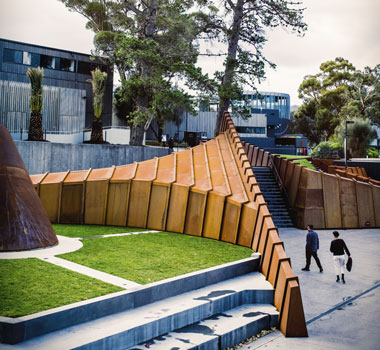
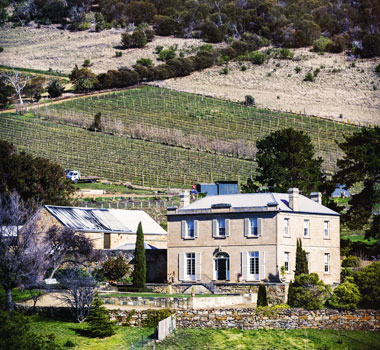
Pictured above (from left to right): Moorilla Estate; the magnificent sandstone Georgian home of Pooley Wines.
One winemaker who knows a thing or two about Tasmania’s wine scene as a whole is Derwent Estate’s John Schuts. Before joining the vineyard in 2014, John was a contract winemaker with Winemaking Tasmania for 11 years, producing wine for many of the state’s smaller, and some larger, vineyards, including up to 35 Pinot Noirs annually. This allowed him to see what really worked in Tasmania and eventually drew him to invest in the picturesque vineyard on the banks of the Derwent River.
As John takes me on a tour of the vineyard and some of its unnervingly steep slopes in his utility, he explains how Derwent Estate’s site mirrors many of the conditions found in Burgundy, where he completed a vintage in 2007. The vineyards are set along one steep north-east facing slope, around a series of moraines and on a base of red loam over limestone, all facing a narrowing section of the Derwent River.
As we climb higher in the vineyard, John explains how he and his team follow “old world Burgundian techniques,” right down to building a cave-like wine cellar.
“But I also fine tune our wine to suit Australian palates,” he says. “Australians rarely cellar their wine, so we’ve taken to ageing our Pinot, for example, one year in the bottle before release, so we can still build some texture and complexity into it. We try very hard to make the wines suitable for food, which is something Burgundy does very well,” John says.
Increasingly, Southern Tasmanian vineyards are introducing restaurants to their establishments, allowing visitors to enjoy their wines with food in a beautiful environment. Derwent Estate is planning to build a new cellar door and restaurant on the high slopes above the vineyard for these very reasons.
Just next door, Stefano Lubiana Wines opened their Osteria restaurant in 2014, offering regional Italian cuisine to accompany their acclaimed biodynamic wine. And across the Wellington Ranges to the South in the cooler Huon Valley, Home Hill Winery has been championing local produce driven dining at their rammed earth cellar door and restaurant since 2001. With Stuart McGushin, previously of Victoria’s Yering Station, recently joining Home Hill as head chef, that tradition is set to continue.
after mona
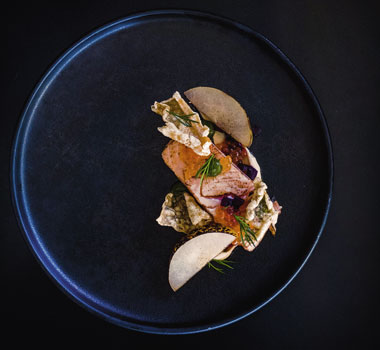
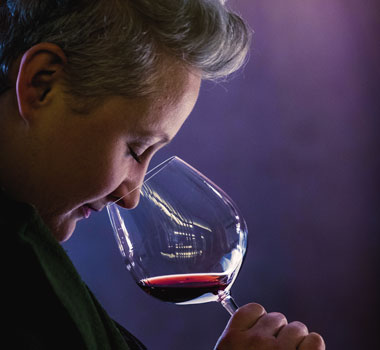
Pictured above (from left to right): One of Home Hill head chef Stuart McGushin’s dishes; Moorilla Estate’s Olivia McMenamin.
Another x-factor has helped the buoyancy being felt across the wine scene in Southern Tasmania. The opening of MONA in 2011 created such a shift in belief and confidence that locals now talk of “before MONA (BM) and after MONA (AM).”
One winemaker who has sought to tap right into the MONA zeitgeist and its urbane visitors is Nick Glaetzer of Glaetzer-Dixon Family Winemakers. Opening Hobart’s first urban winery and cellar door in a disused ice factory on the CBD fringe, Glaetzer-Dixon has given short-stay visitors the opportunity to enjoy Nick’s celebrated wines in the city.
In the moody MONA-esque wine room, Nick tells of how he was working in Margaret River with plans to move to Burgundy to follow his “obsession” with cool-climate wines, when in 2001, in a blind tasting, he tried a Tasmanian Pinot for the first time. “I didn’t even know Tassie made wine,” he says.
Nick changed his plans and moved to Tasmania, scoring a winemaking job with Andrew Hood at Frogmore Creek. In 2008, Glaetzer-Dixon was established as a side project, sourcing fruit from vineyards mostly in the Coal River and Derwent Valleys, but also Riesling from the Tamar Valley.
With their own 12-hectare Coal River vineyard about to come online, Glaezter-Dixon is now Nick’s full-time role and with a Jimmy Watson Trophy to his name, the future of wine in Tasmania is looking bright for the brand.
With a growing number of Tasmanian vineyards “starting to hit their straps” in terms of vine age, Nick believes the best is yet to come. “Not many people outside of Australia know about Tassie Pinot yet. Internationally, they know about our Sparkling, but our table Pinot is going to be the thing,” he says.
While the diversity of Southern Tasmania’s varied wine regions is cause for celebration for the visitor and Tasmanians alike, maybe the real celebration is the promising future of Tasmania as one of the world’s cool climate wine hotspots.